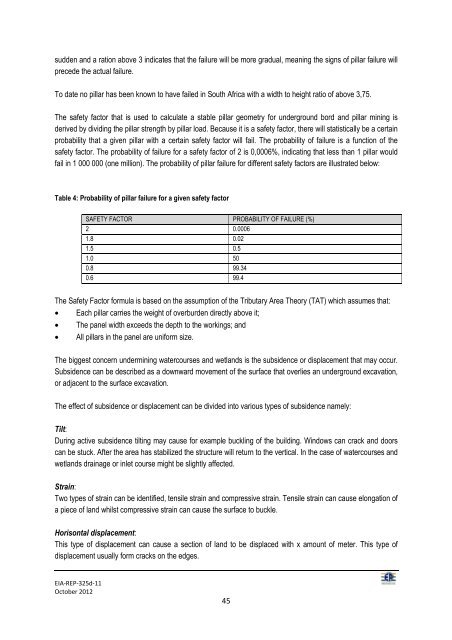EIA-REP-325d-12 _BB_ - 201.09.14.pdf - SAHRA
EIA-REP-325d-12 _BB_ - 201.09.14.pdf - SAHRA
EIA-REP-325d-12 _BB_ - 201.09.14.pdf - SAHRA
Create successful ePaper yourself
Turn your PDF publications into a flip-book with our unique Google optimized e-Paper software.
sudden and a ration above 3 indicates that the failure will be more gradual, meaning the signs of pillar failure will<br />
precede the actual failure.<br />
To date no pillar has been known to have failed in South Africa with a width to height ratio of above 3,75.<br />
The safety factor that is used to calculate a stable pillar geometry for underground bord and pillar mining is<br />
derived by dividing the pillar strength by pillar load. Because it is a safety factor, there will statistically be a certain<br />
probability that a given pillar with a certain safety factor will fail. The probability of failure is a function of the<br />
safety factor. The probability of failure for a safety factor of 2 is 0,0006%, indicating that less than 1 pillar would<br />
fail in 1 000 000 (one million). The probability of pillar failure for different safety factors are illustrated below:<br />
Table 4: Probability of pillar failure for a given safety factor<br />
<strong>EIA</strong>-<strong>REP</strong>-<strong>325d</strong>-11<br />
October 20<strong>12</strong><br />
SAFETY FACTOR PROBABILITY OF FAILURE (%)<br />
2 0.0006<br />
1.8 0.02<br />
1.5 0.5<br />
1.0 50<br />
0.8 99.34<br />
0.6 99.4<br />
The Safety Factor formula is based on the assumption of the Tributary Area Theory (TAT) which assumes that:<br />
• Each pillar carries the weight of overburden directly above it;<br />
• The panel width exceeds the depth to the workings; and<br />
• All pillars in the panel are uniform size.<br />
The biggest concern undermining watercourses and wetlands is the subsidence or displacement that may occur.<br />
Subsidence can be described as a downward movement of the surface that overlies an underground excavation,<br />
or adjacent to the surface excavation.<br />
The effect of subsidence or displacement can be divided into various types of subsidence namely:<br />
Tilt:<br />
During active subsidence tilting may cause for example buckling of the building. Windows can crack and doors<br />
can be stuck. After the area has stabilized the structure will return to the vertical. In the case of watercourses and<br />
wetlands drainage or inlet course might be slightly affected.<br />
Strain:<br />
Two types of strain can be identified, tensile strain and compressive strain. Tensile strain can cause elongation of<br />
a piece of land whilst compressive strain can cause the surface to buckle.<br />
Horisontal displacement:<br />
This type of displacement can cause a section of land to be displaced with x amount of meter. This type of<br />
displacement usually form cracks on the edges.<br />
45

















